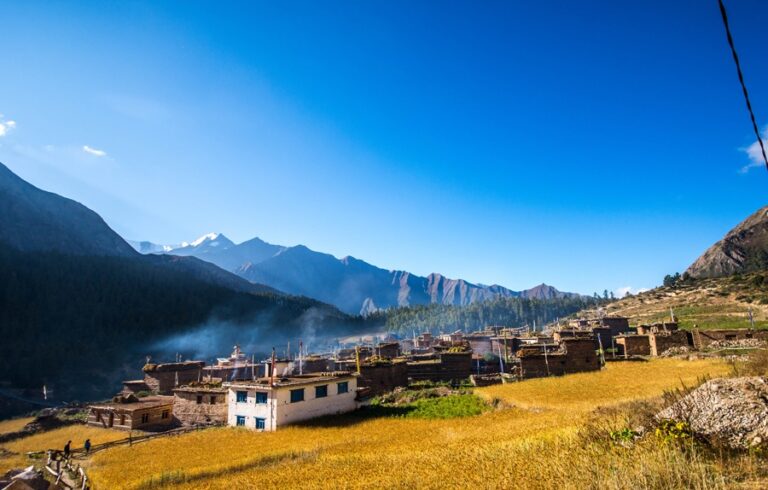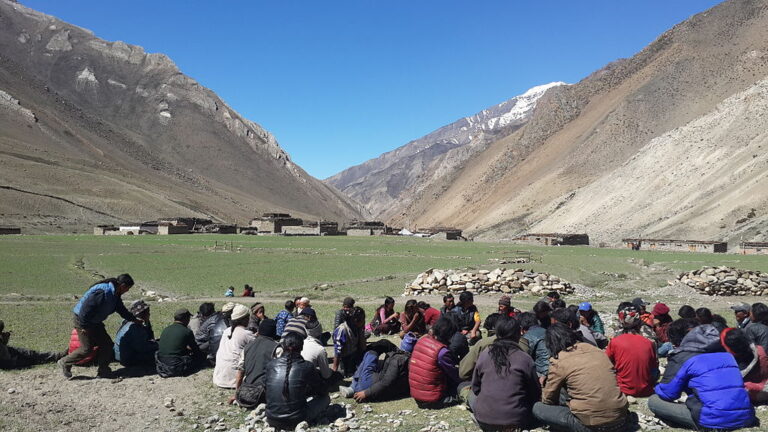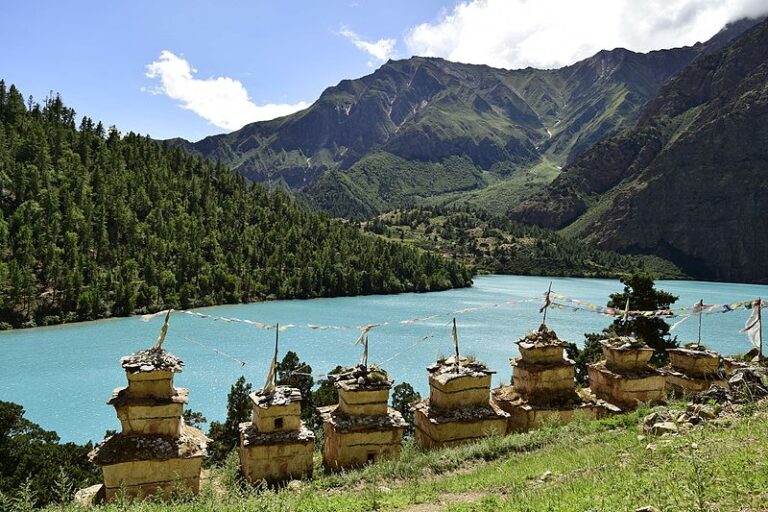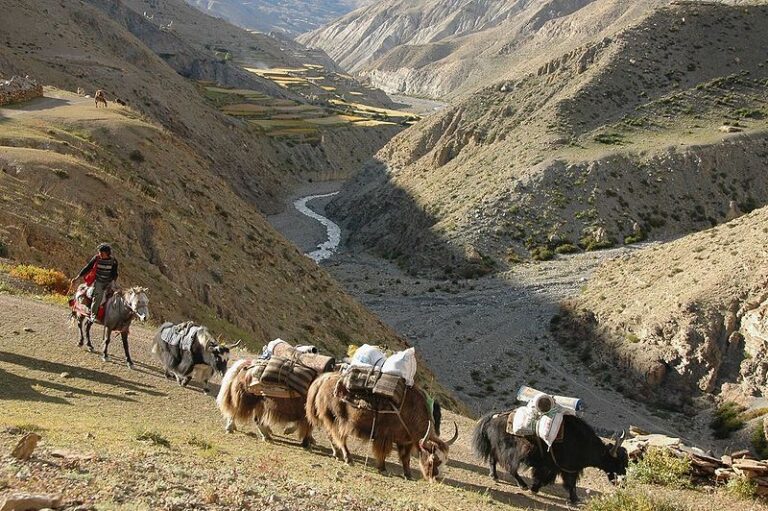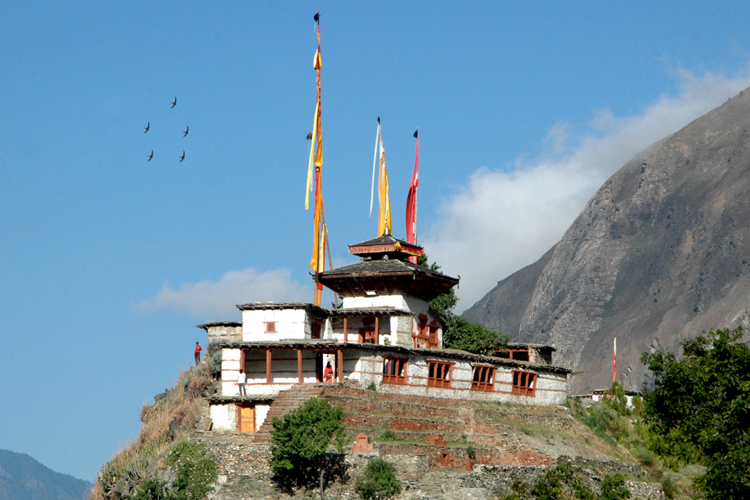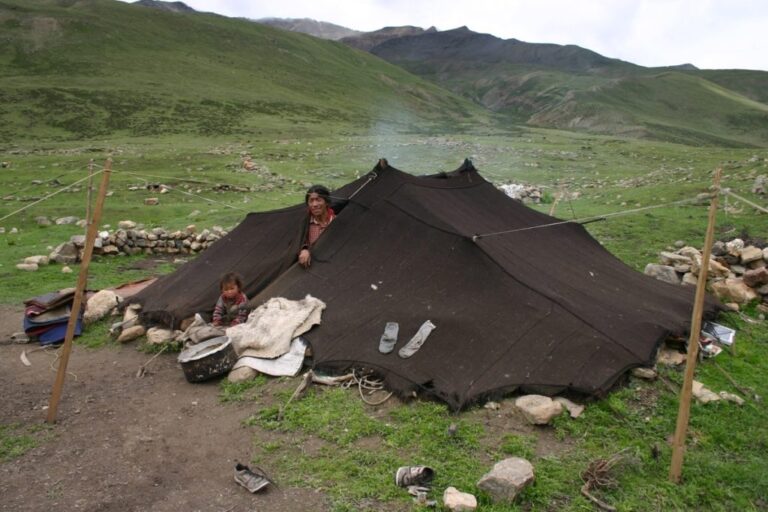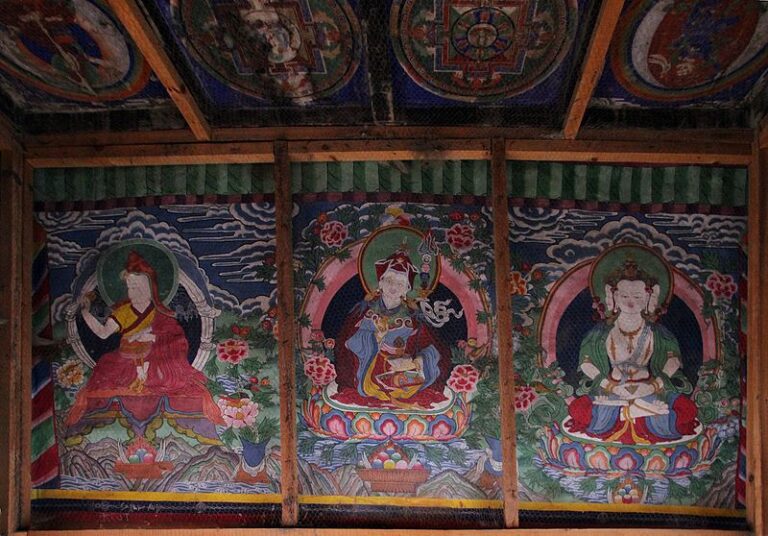Day 01 – Arrival and escort to the hotel – We will pick you up from the Tribhuwan international airport in Kathmandu then you will be transferred to Hotel in Thamel . which is one of the popular tourist’s hubs in Nepal. After checking in the hotel, your guide will brief you about the trekking route, trekking gear, programs, and preparation.
Day 2 – Permit procedure and Fly from Kathmandu to Nepalgunj – we will take an early morning flight to Nepalgunj from Kathmandu. Nepalgunj lies in the Terai region of Nepal where you can experience the change in topography and temperature. Upon arrival, feel free to enjoy and explore the place. Overnight in Nepalgunj.
Day 03 – Nepalganj- Juphal – Dunai camp(2150m.a.s.l.) – 4 hours walk The 35 minutes of scenic flight brings us to Juphal where we will meet our trekking crews. Begins of the trek, we will descend about 45 minutes to get Kalighat. From Kalighat we will head towards Dunai pass by Roop Ghar with charms views of landscapes, waterfalls, and a beautiful Thuli Bheri River. Dunai is a small town and has schools, Police check post, and some of the Government offices. we will stay one overnight at Pala guest house.
Day 04 – Trek to Chhepka(2687m .a.s.l) – 6 hours walk – our journey begins initially walk along the classic trekking route of Dolpo via Kararsialchaur Temple to Sulighat, which is pretty much comfortable walk along the leveled trail until Sulighat. From here, we will walk beside the Phoksundo River until Kageni with beautiful views of the landscape, tropical forest, isolated mid-hills, and two Rivers called Phoksundo Khola and Maiaba Khola. When we reach Shyangte we will cross the bridge twice- once over Phoksundo River and once over the confluence of Phoksundo Khola and Maiaba Khola and begin to head north towards Chhepka. Trekking upstream along the trail beside Phoksundo Khola for a while we arrive at Chhepka. We will set up our tents at an ideal location to spend one overnight.
Day 05 – Trek to Amchi Hospital(3000m.a.s.l) – 6 hours walk – We will walk beside the Phoksundo Khola until beautiful pastureland called Kharka. After a couple of hours of walk, the trail ascends to a peaceful place called Rechi where we will stop for lunch. Beyond the Rechi we head toward Amchi Hospital pass by Bullighat Dobhan, the confluence of two Rivers known as Phoksundo Khola and Yulung Khola. 6 hours of walk brings us to Amchi hospital which is very famous for herbal medicine, collected in Dolpo region.
Day 06 – Trek to Phoksundo Lake(3600m.a.s.l) – 6 hours walk – The pleasant trail leads us through the lush forest of cedar to get Pallam, a winter settlement used by the people of the Ringmo village. From here, the trail descends about 400 meters to get small valley then again ascends to the Phoksundo lake with an awesome view of waterfalls, Ringmo village, a picturesque settlement of flat-roofed stone houses with lots of mani walls.
Day 07 – Exploration of Ringmo village and Phoksundo Lake –
Today we will explore around the Ringmo Village and the magnificent Phoksundo Lake. The exploration commands to see dozens of Monasteries that belong to Bon -PO religion, spectacular view of Phoksundo Lake, traditional houses, and rural life of the Dolpo region.
Day 08 – Trek to Sallaghari (3630m.a.s.l) – 6 hours walk – Today’s trek is probably one of the best trekking days of inner Dolpo trek due to see beautiful views of landscapes, Phoksundo Lake, and rocky hills. The trail ascends along the narrow trail cut on a cliff standing vertically straight above Phoksundo Lake that brings us to another side of Phoksundo Lake. From here we will descend about 90 minutes to get Phoksundo Khola camp and head towards Sallghari through the beautiful forest and sandy shores. when we reach Sallaghari, we will set up our tents at a beautiful ground which is surrounded by the Pine forest.
Day 09 – Trek to Kangla base camp(4100m.a.s.l) – 4 hours walk – We will trek only 4 hours to get Kangla Base camp although we may fill a little bit hard to walk due to high elevation. Most of the time we will ascend following by narrow trail with a delightful view of Tuk Kyaksa River, Pine forest, and a wide valley. After 4 hours of walk brings us to a massive rock slab where we will set up our tents to spend a joyful night.
Day 10 – Trek to Shey Gompa(4290m.a.s.l) – 6 hours walk – Today we have to cross Kangla pass which is 5240 meters high above the sea level. Begins of the trek, we will climb up about 3 hours to get top of the Kangla that commands us to see Cristal mountain, mesmerizing landscapes of Dolpo, Shey Shikkar, and Kang Chunne which are all higher than 6000 meters. From here we will descend about three hours to get Shey Gompa where we will set up our tent to sleep one overnight.
Day 11 – Trek to Namgung Gompa(4360m.a.s.l) 6 to 7 hours walk –Today we will explore Shey Gompa which is believed to be about 800 years old monastery, with murals inside and an ancient scroll describing the mythology behind the Crystal Mountain. The monastery is locally known as Shelri Sumdho Gompa. Shey Festival, the summer festival observed by the people of Dolpo with huge enthusiasm is hosted at Shey Gompa. After the exploration of Shey Gompa, our journey beside Sephu Khola to Shey La pass (5100m) with the views of typical Dolpo landscapes- barren and enchanting. Shey La Pass rewards us with the magnificent views of Mustang to the East, Tibet to the North and Kanjiroba, Kagmara and Riu Dhukta, or the Crystal Mountain, to the West. From here we will trek down to Namgung which is a local nomadic herding settlement.
Day 12 – Trek to Yangjer Gompa (3890m.a.s.l) – 7 hours walk – After breakfast, we will explore a beautiful Monastery called Namgung Gompa and head towards Saldang village which is a beautiful Tibetan village that offers to see lots of drylands, surrounding hills, visit some houses to drink local beer, salt butter tea, Amchi tradition, and Buddhism in Dolpo. After lunch in Saldang, we will head towards Yanger Gompa pass by Nagun Khola, Panjang Khola, Tara Khola, and charms views of dry landscapes.
Day 13 – Trek to Komash Village(4060m.a.s.l) – 6 hours walk – Before leaving Yangjer Gompa, we will explore a monastery called Yangjer Gompa that is said to be built 1000 years ago and drastically different to the other Gompas of Dolpo, Yangjer Gompa holds the images of most of Buddhist deities which include Guru Rinpoche, Chenserig, Skhyamuni Buddha, Dorje Chang, Mahakala protector- Green Tara and the Eight Medicine Buddhas. After an exploration of Yangjer Gompa, we will starts trek of the day through the Saldang lek, Raphya Khola with a beautiful view of the barren hillside, and rocky moraines. The 6 hours of walk brings us to Komash village which seems similar to the Tibetan village.
Day 14 – Trek to Tinze village(4130m.a.s.l) – 6hrs walk – Our trek of the day would be very pleasant due to walk on the leveled trail which leads us beside the Tinje river with charms views of landscapes, deserted lands and also possible to see some wildlife like blue sheep, Himalayan Thar, Ghoral, Deer and many species of birds and butterflies. After 6 hours of walk, we will reach our destination called Tinje village which is a very famous trade point with Tibet and has the first airport in the region. We will set up our tents at the proper place to spend one overnight in Tinze village.
Day 15 – Trek to Yak Kharka(4335m.a.s.l) – 6 hours walk – Our journey to Yak kharka begins the shore of Panjang river to get a small village called Chhamdang then continuously walk beside the Chhamdang Khola with marvelous views of highlands, rocky moraines, the confluence of two rivers called Chholtam and Panjam River. Along the trail, we will cross Thalum Khola on a suspension bridge to get Yak Kharka which means grazing ground for Yaks. Yak Kharka is gigantic grassy land where we can see thousands of grazing Yaks and other domestic animals.
Day 16 – Trek to Tokyu(4240m.a.s.l) – 5 hours walk – Early in the morning, we will cross the Sulun river on a suspension bridge and almost 2 hours of ascending trail drops us a hilltop which 5040 meters high called Cholia north passes. From here, a couple of hours of descending trail, we will get Cholia river and we will follow the Cholia river to get Tokyu, where we will spend one night in the tented camp.
Day 17 – Exploration of Dho Tarap village – Dho Tarap is one of the large and beautiful villages of the region and commands to see numerous interesting things and Buddist monuments like traditional houses, are decorated with colorful Buddhist prayer flags, Chhortens, Mani walls, There are chortens, mani walls, women are wearing a necklace which is made of musk deer’s teeth, and some monasteries called Ribo Bumpa Monastery & Drakmar Dewa Monastery, Mekhyim Monastery, Dhoro Monastery and a Bon Gompa of Shipichowk. In the evening, we will enjoy a cultural program consisting of traditional Tibetan dances and songs presented by the villagers.
Day 18 – Trek to Chhengur Cave(3440m.a.s.l) – 6 hours walk – We will head towards Chhengur cave through the picturesque places and arid landscapes. Most of the time we will walk the shore of two rivers called Tarap Khola and Mirubabane with fascinating views of river gorges, meadows, hanging long suspension bridges, and wonderful houses, activities of local peoples due to walk through the several villages called, Sisaul, Gyamghar, Total, and Nwarpani before we finally stop at Chhengur Cave. We set up the tents at Chhegur Cave to sleep overnight.
Day 19 – Trek to Tarakot(2537m.a.s.l) – 6 to 7 hours walk – Begins of the trek we will walk beside the Tarap Khola and after a couple, hours of walk the trail ascends until Lahini Odar. From here, we will descend until Chhedhul Gompa. Once again, a short walk along the trail beside Tarap Khola we arrive at Laisicap, where they cross the bridge over the confluence of Tarap Khola and Thuli Bheri River. Now on we will trek along the green woodlands high above Thuli Bheri River towards Tarakot. Just before arriving at Tarakot, we cross the bridge over the small stream. Spend one night in Tarakot.
Day 20 – Trek to Juphal(2457m.a.s.l) – 6 hours walk – The pleasant walk beside the Thuli Bheri river purpose to see the beautiful river valley, green forest with cascading waterfalls, cultivated terraced field, and some beautiful villages. we will stop in Dunai to have our lunch the continuously trek to Juphal where we will celebrate our last night of the trek.
Day 21 – Fly back from Juphal- Nepalganj- Kathmandu.
Day 22 – Rest day in Kathmandu.
Day 23 – Final departure – After the successful trip of Inner Dolpo, you will return to your homeland with great experiences of Dolpo trek, differents caste culture, Nepalese rural life that make you a storyteller among your friends, family, and colleges.
